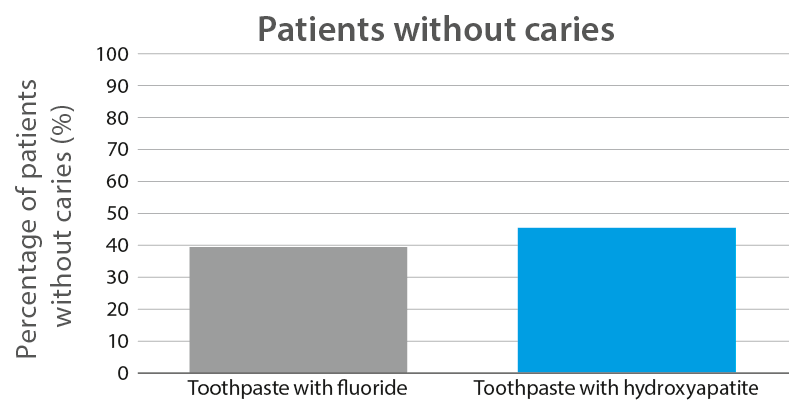The efficacy of hydroxyapatite has been proven in several in-situ and in-vitro studies on the treatment of dental cavities. Many patients are not always able to brush their teeth properly. This includes nearly all patients with fixed orthodontic braces. Consequently, brace wearers have an elevated risk of dental cavities. To investigate the efficacy of hydroxyapatite in the case of a high risk of dental cavities, this patient group was selected. The former gold standard, an antibacterial fluoride toothpaste, was chosen as the comparator product.
Question
Is hydroxyapatite as clinically effective as fluoride in the prevention of dental cavities in high-risk patients?
Materials and methods
This multicentric, double-blind, randomised clinical study was conducted at five university hospitals in Germany. The age of the test subjects ranged between 11 and 25, constituted an at-risk dental cavities group (orthodontic treatment) and were recruited at the time of the initial presentation. At the beginning of study, no test subjects had cavities. Professional cleaning was performed prior to the orthodontic treatment. Any cavities that occurred was assessed using the ICDAS code (International Caries Detection and Assessment System; www.icdas.org). An ICDAS code of 2 or greater was set as the primary endpoint. The study was conducted over 6 months. Studies show that decay is detected in this risk group after 6 months. The test subjects were called in regularly for check-ups, at which tooth status was determined.
The test subjects were randomised into two groups after recruitment: a test group with a hydroxyapatite toothpaste.
A control group with an antibacterial amine/stannous fluoride toothpaste.
Results
A total of 150 test subjects were recruited and divided equally across the two groups. Whilst cavities as defined in ICDAS 1 developed in 60.9% of subjects in the amine/stannous fluoride group, this kind of carious change in enamel was observed in only 54.7% of subjects in the hydroxyapatite group. The difference was even greater for ICDAS 2: In the amine/stannous fluoride group, 34.8% developed cavities, whilst only 23.4% of the test subjects in the test group who brushed their teeth with hydroxyapatite toothpaste were diagnosed as defined with ICDAS 2. No statistically significant differences could be seen between the two tested toothpastes.
Conclusion
A hydroxyapatite toothpaste is clinically as effective in preventing cavities as a fluoride toothpaste.
The published study can be read here.
Source: Schlagenhauf, U. et al. Impact of a non-fluoridated microcrystalline hydroxyapatite dentifrice on enamel caries progression in highly caries-susceptible orthodontic patients: A randomized, controlled 6-month trial. J Invest Clin Dent 10, e12399 (2019).


